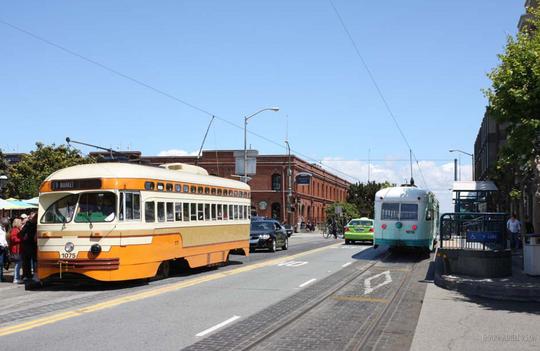Yesterday’s Chronicle carried a nice little David-Goliath story pitting starting artists against streetcars, suggesting that if a proposed stop on the planned F-line extension from Fisherman’s Wharf to Aquatic Park and Fort Mason stays where currently envisioned, that streetcar stop would greatly harm the street artist community.
Well, as one of my cynical editors once said to me in my journalism days, “Never let the facts get in the way of a good story.”
That seems to be what happened with this story. It’s just factually wrong.

Artist’s concept of a possible F-line stop on Beach Street at Hyde, with artists’ stalls right beside the stop, which would replace current automobile parking spots in the curb lane.
The Chronicle states as fact that the streetcar platform “would eliminate 30 of 45 spots licensed by the city for artists, who view the move as a threat to their already strained livelihoods.”
The problem is that nothing like that appears in the actual document cited in the article, the Draft Environmental Impact Statement (DEIS) on the proposed streetcar extension, which we’ve reported on before. What the DEIS actually says is that the number of artists spaces lost to a streetcar stop is likely to be zero. That means none. At most, it would be 12, and that only a few days a year.
As the DEIS makes clear, the stop would NOT be built on the sidewalk where the artists sell their works, but rather on a new platform built next to the sidewalk in what is now the parking lane. It then states (p.209), “continued operation of the street vendors may be permitted.” In fact, the conceptual drawing contained in the DEIS (above) clearly shows street artist umbrellas easily coexisting with the F-line streetcar stop. But, the DEIS continues, “conservatively assuming that the street vendors spaces located directly next to the platform might not be permitted to operate (and could not be accommodated without encroaching on Victorian Park) then up to 12 vendor spaces could be removed.” That’s 12. Not 30.
Even then, the DEIS points out that many of the authorized artist stalls farther west on Beach Street sit empty most of the time, “and generally only fully occupied on peak weekends” so that the actual reduction of artist spaces that are actually used would be infrequent at best. The DEIS notes that the artist spaces could be shifted further west to avoid losing any stalls at any time, and makes the point that since the F-line is very popular and is expected to shift visitors from their automobiles to transit, “Arguably, these spaces and other vendors along Beach Street may experience greater pedestrian traffic and potential customers.”
Actually, the argument for that is quite strong, since many streetcar riders could be expected to alight at Hyde and Beach for Ghirardelli Square, the Maritime Museum, and other attractions, walking right past the artists’ stalls to do so. However, if the stop were to be moved westward to Larkin, riders would roll past the artists while still on the streetcars, getting off right at Ghirardelli Square, thus likely missing the artists’ stalls altogether.
Yet, following complaints from some street artists, the Arts Commission has written a letter asking that the stop be moved west.
For the record, Market Street Railway is fine with putting that westbound streetcar stop at either location on Beach — Hyde or Larkin. We just hope the final placement of the stop is based on actual facts, not misunderstandings or misinformation.
We’re certainly empathetic with the street artists’ need to make a living. That’s why we respectfully request that the artists — and the Arts Commission, which is supporting them — think a little more about the implications of demanding that all those streetcar passengers be carried past their stalls, when they could have them dropped off right in their laps.
Kinda reminds us of the arguments about the current F-line terminal in Fisherman’s Wharf. A number of merchants back then said, in effect, “No way I want that streetcar stopping in front of my store.” In part because of a few people’s gripes, the F-line terminal ended up being located in front of what was then the blank ground floor wall of the Anchorage garage on Jones Street. It wasn’t long before the Anchorage owners got it — and ripped out parking spaces in their garage to build ground floor retail, including a Starbucks and a Walgreens that are delivering lots of green to the garage owners.
Muni’s historic streetcars have brought a lot of economic activity to businesses all along their route. They can do the same for the street vendors at Aquatic Park too.
By the way, while factually wrong, the Chronicle article has a positive benefit: reminding people that this extension is moving toward the end of its planning phase. The comments from readers universally supported the idea of extending the F-line, most with great enthusiasm. As one said, “What an excellent idea! I really hope it happens. It would be great to extend the F line out to Fort Mason. How nice to have public transportation that will take you straight to the Fort. And how fun to open up that old, historic tunnel.”
The Art Commission’s got a lot of explaining to do as is with recommending a dog killer for art at the Central Subway (vs. say, a LOCAL artist), so it’s not surprising they’re engaging in fiction, not facts here.
It’s always the same.
The shop owmners whine when a new streetcar line is to be built, and they whine again when it’s about to go.
Like in Nuremberg, Germany, right this time. A subway extension is about to open, which will replace a part of a streetcar line. Now the business owners wake up and argue about “how could this happen”- meanwhile, in another part of the same city, the shop owners fear that “these steel monsters” will soon take away all customers, and parking space…